Search the Special Collections and Archives Portal
Search Results
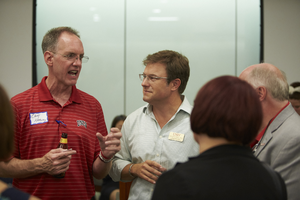
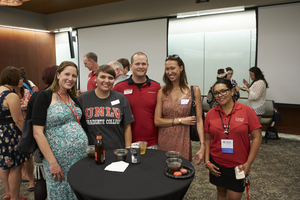

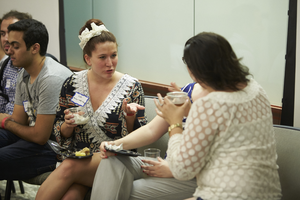
Billy Root oral history interview
Identifier
Abstract
Oral history interview with Billy Root conducted by Lisa Gioia-Acres on May 14, 2008 for the All That Jazz Oral History Project. Root begins by discussing his upbringing in Philadelphia, Pennsylvania where he developed an early interest in being a musician due to encouragement from his father, who was also a musician. He describes playing baritone saxophone in the Philadelphia Orchestra, performing at the Apollo Theater in Ella Fitzgerald's orchestra, and going on tour with a predominantly African American jazz band in the Southern United States during segregation. Root details his interactions and impressions of various celebrities, such as Frank Sinatra and Tony Bennett, attending Playboy parties, and eventually deciding to settle in Las Vegas, Nevada. He discusses working as a professional musician in Las Vegas, where he performed in such casinos as the Dunes and the Desert Inn. He concludes by discussing his retirement and his family.
Archival Collection
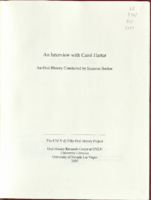
Transcript of interview with Carol Harter by Suzanne Becker, April 20, 2007
Date
Archival Collection
Description
Carol Harter and her husband of 46 years started their married lives by running away from college in their sophomore year. They spent the 60's working toward their degrees. Carol earned her bachelor's in 1964 and her master's in 1967. One of her professors encouraged her to go for her PhD at a time when women simply did not aspire to such heights. Dr. Harter completed her PhD in 1970, and because her husband wanted to work on his doctorate, they moved to Athens, Ohio. She taught at Ohio University while he completed his courses. They lived and worked and raised their children there for 19 years. Carol held the positions of ombudsman (2 years), vice president and dean of students combined (6 years), and vice president at the university, and then accepted the position of president at SUNY Geneseo (in New York). Carol was nominated for the presidency at UNLV in 1994, and she accepted the job in 1995. Her career here has been phenomenal, as she saw the potential of this very young university and set about bringing in the faculty, the funding, the buildings, and the vision to create a first-rate research oriented facility. During her administration, the new library went up, the law school and dental school were built, and over 550 million in gifts and pledges were raised. This includes money raised for the "Invent the Future" campaign. Under Dr. Harter's guidance, women's sports were expanded, multiple graduate degrees were developed, more money for research and buildings was raised, and UNLV has become a major research university. Dr. Harter leaves behind a rich legacy, including her vision of the UNLV Midtown project, a cultural district where the university may one day interface with the community.
Text
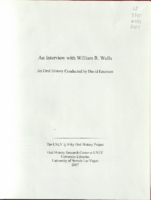
Transcript of interview with William R. Wells by David Emerson, May 22, 2006
Date
Archival Collection
Description
Text

neo000027-001
Description
Notes: The horizontal neon bars chase each other from bottom to top, and the incandescent bulbs oscillate rapidly. The two, rosebud type figures in the rear of the property also animate in the same fashion. The incandescent bulbs in the logo text above the old porte-cochere also oscillate. The bulbs in the faceted fascia below the old porte-cochere oscillate rapidly. The two, logo/text signs on the new porte-cochere are also filled with incandescent bulbs that oscillate also. The crest item that sits on the southwest corner of the building is lined with incandescent bulbs that chase downward, down raceways, running the length of the building. The bulbs chase all the way until the end of the tracks. The logo, above the bulbous plumage, on the east face of the southernmost tower is also filled with oscillating incandescent bulbs, while the neon bars and incandescent bulbs on the plumage below the text chase upward from bottom to top.
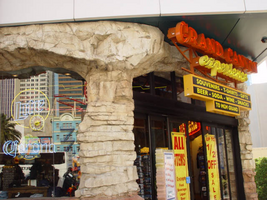
neo000029-001
Description
Notes: The horizontal neon bars chase each other from bottom to top, and the incandescent bulbs oscillate rapidly. The two, rosebud type figures in the rear of the property also animate in the same fashion. The incandescent bulbs in the logo text above the old porte-cochere also oscillate. The bulbs in the faceted fascia below the old porte-cochere oscillate rapidly. The two, logo/text signs on the new porte-cochere are also filled with incandescent bulbs that oscillate also. The crest item that sits on the southwest corner of the building is lined with incandescent bulbs that chase downward, down raceways, running the length of the building. The bulbs chase all the way until the end of the tracks. The logo, above the bulbous plumage, on the east face of the southernmost tower is also filled with oscillating incandescent bulbs, while the neon bars and incandescent bulbs on the plumage below the text chase upward from bottom to top.

